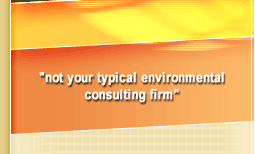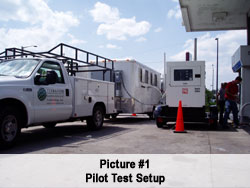Problem
Site assessment defined a contaminated soil source area located beneath the western dispenser island and canopy footer. The contaminated soil source is located within a sandy clay-rich lithology with depth to groundwater below 25 feet below land surface. Source removal by excavation would have been the preferable method of remediation except that this option would require removal and re-installation of the canopy, dispenser island and product piping. Air sparge with vapor extraction was considered the most feasible remedial option and a pilot tested was conducted to determine the effectiveness and site specific design specifications for this site.
Solution
On April 26th and 27th of 2006, one vertical vacuum extraction well, and one air sparge well were installed on the property for use in the pilot test. Additionally, three temporary 1.5-inch diameter PVC wells were installed for monitoring purposes during the pilot test.
For the vacuum extraction pilot test, TERRA-COM conducted a four-phase vacuum extraction test using settings of 30, 40, 50, and 60 in. H20. After plumbing the pilot test equipment (Picture 1 & Picture 2), establishing power, and collecting baseline measurements of the groundwater elevations and distances to the observation wells, TERRA-COM started the vacuum extraction (VE) system independently of the air sparge (AS) system. TERRA-COM used temporary wells to monitor the vacuum induced within the soil matrix and to monitor changes in the groundwater elevation surrounding the VE well. For each setting (Picture 3), the system was operated until temporary well measurements stabilized. The VE system had some difficulty inducing vacuum within the soil matrix.
TERRA-COM then turned off the VE system and began independent operation on the AS system. The theoretical injection pressure that was calculated and shown in the pilot test plan was 9.98 psi. However, the breakthrough did not occur until 18 psi. Therefore, the air sparge system was operated at approximately 16 psi and 7 cfm. As the air sparge testing progressed, the system pressure gradually decreased, whereas the system flow rate slowly increased. However, there was not any substantial increase or decrease of induced air sparging pressure measured in the observation wells.
TERRA-COM then operated both the VE and AS systems together. The VE system was operated at a vacuum of 40 inches of water at the wellhead and the air sparge system was operated at 14 psi at the wellhead. The VE and AS systems were operated for approximately one hour until temporary well measurements stabilized (Picture 4).
The results of the pilot test indicate that the site, although not conducive to AS remediation technology, is somewhat conducive to VE technology based on pressure and vacuum measurements collected at the observation wells. This was concluded upon viewing the limited extent of the radius of influence for the AS test which extended only 5.13 feet from the air sparge well. The radius of influence which resulted from the VE test extended almost to 13 feet; however, due to the amount of water that was drawn into the piping at even the lowest setting, TERRA-COM would not recommend vacuum extraction or air sparging as the best remedial alternative. The poor results achieved from the pilot test can most likely be attributed to a high concentration of clay surrounding the contaminated area, which render vacuum extraction and air sparging less effective than other possible alternative cleanup options such as in-situ chemical oxidation.


